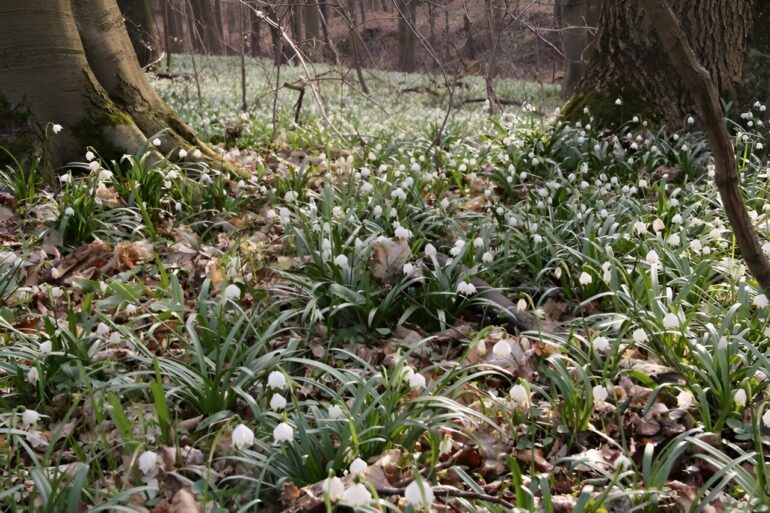Researchers from the Max Planck Institute for Biogeochemistry in Jena and the Ilmenau University of Technology, Germany, have shown that plant observations collected with plant identification apps such as Flora Incognita allow statements to be made about the developmental stages of plants—both on a small scale and across Europe.
“The snowdrops have never bloomed as early as this year, have they?” Many people who explore nature with keen senses will surely have asked themselves such questions. The German Weather Service (DWD) has already reported that the phenological early spring is already in full swing this year—three weeks earlier than the long-term average.
Many plants in temperate latitudes go through the same cycle of flowering, leaf emergence, fruit formation, leaf coloration, and leaf fall every year. The recurring sequence of these events is known as phenology and is closely linked to the prevailing local climatic conditions. Climate changes influence these developmental phenomena, and various plant species react differently to changes, such as the arrival of an earlier spring.
This has not only consequences for the natural food chains, but also for the timing of certain agricultural processes. In ecological terms, it can result in plants already flowering, but the corresponding pollinator insects have not yet hatched or are active. Due to the changes brought about by climate change, it is of great importance to document the plant phenology of as many species as possible over large areas and over long periods of time.
Traditionally, phenological monitoring, e.g., by the German Weather Service (DWD), is carried out with the help of trained volunteers. However, the number of these citizen scientists has been in sharp decline for years. Another limiting factor is that such data collection is usually restricted to certain countries, regions, and plant species.
In two new research papers, scientists from the Max Planck Institute for Biogeochemistry (MPI-BGC) in Jena and the Ilmenau University of Technology have shown that plant identifications using free smartphone apps such as Flora Incognita or reporting data from platforms such as iNaturalist can map differences in the phenology of plant species and are therefore very well suited as a new, growing data source for further research questions.
In a new publication, the researchers show that, for some species, the observation patterns of Flora Incognita correspond very well with those of the German Weather Service. For example, if the DWD registers an earlier start of flowering of the elderberry in one year compared to the previous year, this shift is also reflected in the identification requests in Flora Incognita.
This is because as soon as plants start to flower, they catch the eye of interested individuals, and the number of identification requests increases rapidly.
Negin Katal, a Ph.D. student at the MPI-BGC and first author of the study, says, “Users of Flora Incognita benefit twice: they learn more about plants while exploring nature and at the same time collect important data for phenological monitoring in Germany and Europe.”
In a second publication, the researchers show that smartphone observations of many plant species reflect known supraregional phenological patterns, for example, the later flowering of species in northern and eastern Europe or depending on the altitude of the terrain.
“We were able to show that phenological patterns can be found in citizen science data, even though they were not recorded for the purpose of phenology monitoring,” explains Dr. Michael Rzanny from the MPI-BGC and first author of the study. “Certain events such as the start of flowering can be read from the data—even on larger scales.”
Prof. Patrick Mäder, co-leader of the Flora Incognita project at the Ilmenau University of Technology, comments, “The present work clearly shows that the efforts in the development of the Flora Incognita app, especially in AI-based automatic identification will also be fruitful for research five years after the first release of the app. We are enabling a large number of people with different botanical backgrounds to participate in phenological monitoring.”
“We are delighted that some users take pictures of the blooming of snowdrops or the elderflower every year, even if they have known the species for a long time,” adds Dr. Jana Wäldchen, co-project manager at the MPI-BGC. “Consciously perceiving the life cycles of plants is a good way to engage with the changes in nature, and Flora Incognita makes documentation easy.”
The results of both research projects show that new data sources such as identification apps and reporting platforms can do more than satisfy individual curiosity: they provide a reliable source for the spatial and temporal occurrence of plant species and enable research on various questions.
The findings are published in the journals npj Biodiversity and Frontiers in Plant Science.
More information:
Michael Rzanny et al, Opportunistic plant observations reveal spatial and temporal gradients in phenology, npj Biodiversity (2024). DOI: 10.1038/s44185-024-00037-7
Negin Katal et al, Bridging the gap: how to adopt opportunistic plant observations for phenology monitoring, Frontiers in Plant Science (2023). DOI: 10.3389/fpls.2023.1150956
Provided by
Max Planck Society
Citation:
Plant identification via app enables phenological monitoring (2024, March 14)



